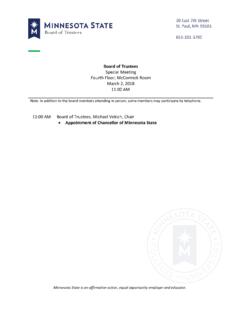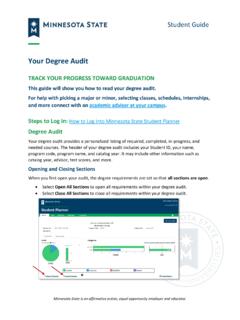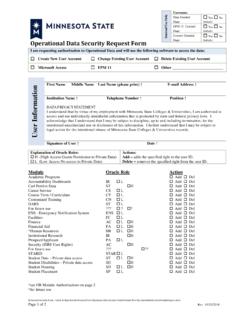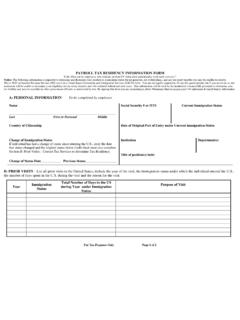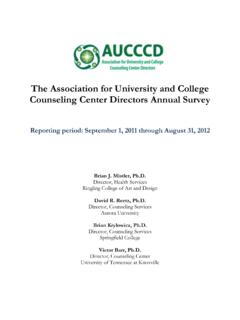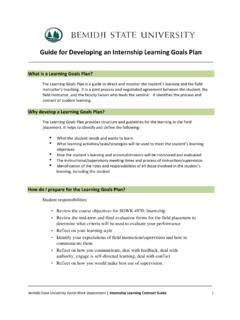Transcription of Banking Controls Internal Control and Compliance Audit
1 Minnesota State Colleges & Universities Office of Internal Auditing Page 1 Banking Controls Internal Control and Compliance Audit Office of Internal Auditing Reference Number 2013-04-002 Public Release Date April 16, 2013 CO N T E N T S PAGE I. Background 2 II. Audit Objectives, Scope, Methodology and Conclusion 4 III. Internal Control -Related Audit Findings and Recommendations 6 IV. Compliance -Related Audit Findings and Recommendations 10 V. Considerations for System Leaders 14 VI. Management Response 18 Members of the MnSCU Board of Trustees Chancellor Steven J. Rosenstone College and university Presidents This report presents the results of our Internal Control and Compliance Audit of Banking Controls . It contains nine findings and recommendations to assist colleges, universities, and the system office in improving business processes, Controls , and accountability.
2 We conducted this Audit in Compliance with the Institute of Internal Auditors: Standards for Professional Practice of Internal Auditing. The results of the Audit were discussed with the system office and the finance advisory group on April 2, 2013. We appreciate the excellent cooperation and assistance that we received from employees at the colleges, universities, and system office. Beth Buse, CPA, CIA, CISA Executive Director Executive Summary Background Each college, university , and the system office is responsible for its Internal Controls related to their local Banking and investment activity. MnSCU had over 130 local bank and investment accounts. Over $1 billion in receipts flow through local bank accounts annually. Conclusion MnSCU generally had adequate Internal Controls over Banking activities. For items tested, MnSCU generally complied with finance-related legal requirements and applicable policies, procedures and guidelines. Findings and Recommendations Institutions lacked guidance to help them determine the Banking Controls needed to address evolving risks (Finding 1).
3 Most institutions did not periodically review and recertify employee s access to bank and investment accounts (Finding 2). Several colleges and universities did not adequately separate some job duties and some employees had unnecessary access (Finding 3). Findings 4 8 address various Compliance -related issues. Considerations for System Leaders Evaluate the overall Banking strategy for the system. Opportunities may exist to save money on Banking services, improve Controls , and maximize earnings on investments. Evaluate opportunities to develop more standardized practices for local bank reconciliations. The Audit was led by Melissa Primus and included the following Audit staff: Carolyn Gabel, Craig Fautsch, Kim McLaughlin, and Marita Hickman April16, 2013 Banking Controls Internal Control and Compliance Audit Minnesota State Colleges & Universities Office of Internal Auditing Page 2 Section I: Background MnSCU colleges, universities, and the system office ( institutions ) had over 130 local bank and investment accounts of which 74 were checking and savings accounts.
4 Institutions maintain local bank accounts to deposit receipts from a variety of sources. Some receipts remain in them until they are spent or invested while others are swept or moved by the State of Minnesota into the state s bank account (state treasury). Examples of receipts swept by the State include tuition, fees, and room and board. Examples of receipts that remain in local bank accounts include auxiliary services such as parking, food service, and bookstore receipts, as well as other receipts such as federal student financial aid and scholarship and endowment funds. As noted in Table 1, over $1 billion in receipts flow through local bank accounts each year. In addition, over $770 million in student loan activity flows through the local bank accounts. Table 1: Tuition, Fees, and Sales, Net for Year Ended June 30 (In Thousands) Carrying Amount 2012 2011 2010 Tuition $853,040 $832,637 $784,601 Fees 89,724 95,052 92,521 Sales and room and board 133,301 135,871 137,771 Restricted student payments 109,698 106,308 100,226 Totals $1,185,763 1,169,868 $1,115,119 Source: Minnesota State Colleges and Universities Annual Financial Report for the Years ended June 30, 2012 and June 30, 2011 (Note 12 Gross).
5 As noted in Table 2, the system had approximately $114 million in cash and cash equivalents in local bank accounts and approximately $793 million in the state treasury at June 30, 2012. Table 2: Cash and Cash Equivalents for Year Ended June 30 (In Thousands) Carrying Amount 2012 2011 2010 Cash, in bank $56,362 $60,809 $46,487 Money markets 8,832 5,573 4,508 Repurchase agreements 17,317 13,501 7,736 Restricted local cash 454 434 414 Cash, trustee account (US Bank) 31,242 86,255 47,705 Total local cash and cash equivalents $114,207 $166,572 $106,850 Total treasury cash accounts 793,130 754,154 658,524 Grand Total $907,337 $920,726 $765,374 Source: Minnesota State Colleges and Universities Annual Financial Report for the Years ended June 30, 2012 and June 30, 2011 (Note 2). Institutions are allowed to invest local funds. Minnesota statutes allow institutions to invest funds in depository type accounts or in longer term investments, limited to government bonds, notes, bills, and mortgage backed securities, excluding high risk mortgage backed securities.
6 The value of these investments at June 30, 2012, exceeded $26 million. April 16, 2013 Banking Controls Internal Control and Compliance Audit Minnesota State Colleges & Universities Office of Internal Auditing Page 3 Online Banking has grown over the past several years and is used by every MnSCU institution. Institutions use it for a variety of reasons including accessing critical information and initiating ACH payments and wire transfers. While online Banking provides convenience, it also introduces risks that need to be addressed. Each college, university , and the system office is responsible for managing its own Controls related to their local Banking and investment activity. Examples of key Controls include: Reconciling bank accounts to MnSCU s accounting system. Reconciling MnSCU s accounting system to the State of Minnesota s accounting system. Collateralizing bank accounts. Positive Pay: Transmitting payment information to the bank so it can match the checks an institution issues with those presented to the bank for payment.
7 Any check considered to be potentially fraudulent is flagged for the institution to examine. Limiting employee access to local bank accounts and Banking transactions based on job responsibilities and business need. Separating duties so no one individual can Control a process from start to finish. Dual Controls such as requiring more than one individual to approve riskier transactions such as wire transfers. April16, 2013 Banking Controls Internal Control and Compliance Audit Minnesota State Colleges & Universities Office of Internal Auditing Page 4 Section II: Audit Objectives, Scope, Methodology, and Conclusion Objectives The objectives for this Audit were to answer the following questions: Did colleges, universities, and the system office Internal Controls provide reasonable assurance that bank financial activities were adequately safeguarded, accurately recorded in the accounting records and complied with finance-related legal requirements?
8 For the items tested, did colleges, universities, and the system office comply with significant finance-related legal requirements, including state laws, regulations, contracts, and applicable policies, procedures, and guidelines? Do opportunities exist for management to improve business processes over Banking Controls to make them more efficient and effective? Scope and Methodology Our Audit scope included Banking -related Internal Controls of the system office and MnSCU s 31 colleges and universities. The 31 colleges and universities are defined by the number of presidents. However, three presidents oversee nine institutions; five colleges comprise the Northeast Higher Education District, Anoka Ramsey Community College and Anoka Technical College is aligned as are bemidji State university and Northwest Technical College. Banking is managed separately at each of these locations. As a result, we considered and separately surveyed 37 colleges and universities as well as the Northeast Service Unit and the system office.
9 The areas of focus included: Bank account reconciliations Banking contracts and investment and collateral requirements Banking transactions such as initiating withdrawals, check payments, and electronic payment transactions such as ACH and wire transfers Employees access and ability to initiate Banking transactions via MnSCU s accounting system, in person at a bank location, or online Other Controls such as positive pay, dollar limits, and dual Controls or approvals In addition to surveys, we reviewed relevant documentation such as MnSCU policies, procedures, and guidelines and considered risks of fraud and errors and potential noncompliance with finance-related legal requirements in designing our Audit approach. We analyzed data to identify unusual transactions or significant changes and reviewed computer system to identify transactions that staff could initiate, approve, or process to determine whether duties were adequately separated. Finally, we selected a sample of transactions and reviewed supporting documentation to test whether the Controls were effective and if the transactions complied with legal requirements and MnSCU policies, procedures, and guidelines.
10 April 16, 2013 Banking Controls Internal Control and Compliance Audit Minnesota State Colleges & Universities Office of Internal Auditing Page 5 Overall Conclusion Colleges, universities, and the system office generally had adequate Internal Controls to provide reasonable assurance that Banking activities were adequately safeguarded, accurately recorded in the accounting records, and complied with finance-related legal requirements. For items tested, colleges, universities, and the system office generally complied with significant finance-related legal requirements, including state laws, regulations, contracts, and applicable MnSCU policies, procedures, and guidelines. We did, however, identify several Internal Control deficiencies that are discussed in Section III: Internal Control -Related Audit Findings and Recommendations. We also noted a few examples of noncompliance that are discussed in Section IV: Compliance -Related Audit Findings and Recommendations.


